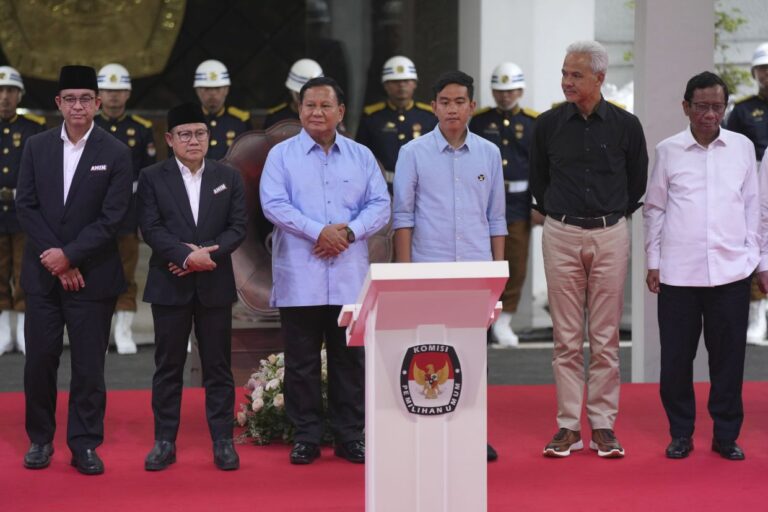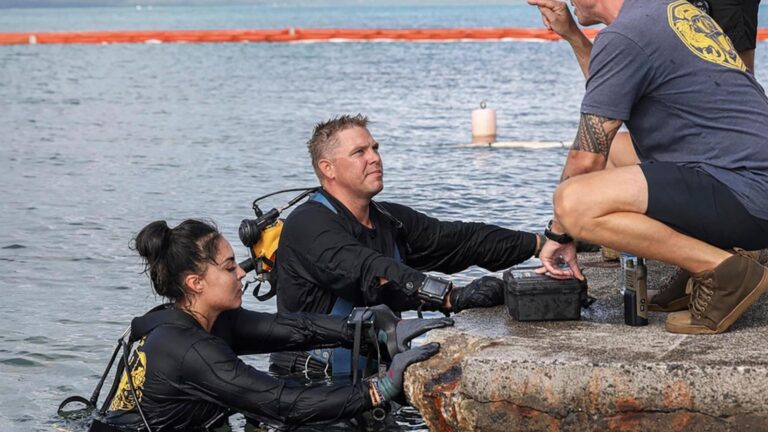PABRADĖ, Lithuania — An enemy force had set its sights on Lithuania and was advancing rapidly on the small Baltic nation from the south, with the aim of capturing a major city.
Tanks and armored fighting vehicles maneuvered through dense forest terrain, the ground oozing with slippery mud. The next day, soldiers were on the streets, engaging in urban combat.
The battle for Lithuania’s territorial integrity was dirty, cold and wet but at least for now, hypothetical. The attackers were American soldiers, the defenders were Lithuanians and mixed among them were troops from Poland, Portugal and Norway.
This month’s Strong Griffin 2023 was the first time the U.S. contributed large numbers of soldiers — 700 of them — and firepower to the Lithuanian military’s annual exercise in a show of American commitment to defending NATO’s most exposed and at-risk flank.
The exercise involving about 2,200 troops also came nearly two years after Russia launched a very real, full-scale invasion of Ukraine, which like Lithuania and the rest of the Baltics once belonged to the Soviet Union.
“All the time you feel the threats coming, how it’s very close to you,” said Col. Aurelijus Alasauskas, commander of the Lithuanian army’s Griffin Brigade. “When you train your soldiers in peacetime, that’s one story. It’s a totally different story when you understand that one day things can change. … All the time we have to remind our soldiers: This is a real thing we have to train for.”
No one at the General Silvestras Žukauskas Training Area in Pabradė would mention Russia by name. But the simulation of an invasion by a “peer enemy” took place just 10 miles from Belarus, Russia’s closest ally, host to Russian troops and tactical nuclear weapons and the staging post Russian soldiers used to storm into Ukraine from the north last year.
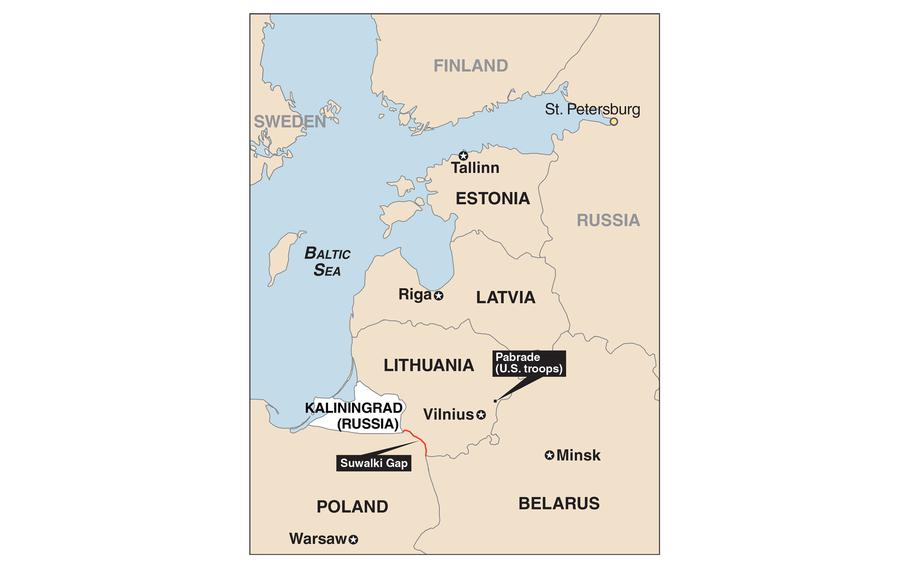
(Noga Ami-rav/Stars and Stripes)
The Baltics no longer consider Belarus an autonomous country, viewing it instead as a “satellite of Russian military intentions,” said Artis Pabriks, a former Latvian defense minister. Any future Russian aggression is expected to come from both countries simultaneously, he said.
Valery Karbalevich, an independent Belarusian analyst, estimates that 1,500 Russian soldiers are in Belarus — a huge drop from the 30,000 troops in the country at the start of the war in Ukraine. Only about 500 of the thousands of Wagner Group mercenaries exiled to Belarus this summer after a brief mutiny remain in country, some working as instructors for the Belarusian military, he said.
“There are no real Belarus-Russia military bases on the territory of Belarus right now, but at any moment Belarus’ military infrastructure can be used by Russia for some kind of aggression,” Karbalevich said.
The threat from Russia looms especially large in the Baltics, where scars from a 50-year Soviet occupation marked by deportations to Siberia remain. Kaliningrad, Russia’s heavily militarized exclave that was once part of Germany, sits on Lithuania’s southwestern border. Estonia borders the Russian mainland, and Latvia is squeezed between Russia to its east and Belarus to its south.
Though bogged down in Ukraine, Russia has the ability to exert “credible military pressure” on the Baltics and could reconstitute its military presence near the Baltic states’ borders within four years, according to a report this year by Estonia’s Foreign Intelligence Service.
The tiny Baltic nations, which have a combined population of 6 million people and a total land mass that is lightly smaller than Missouri, are dwarfed by Russia, the world’s largest country by land area.
“Russia considers the Baltic states to be the most vulnerable part of NATO, which would make them a focus of military pressure in the event of a NATO-Russia conflict,” the Estonian service said.
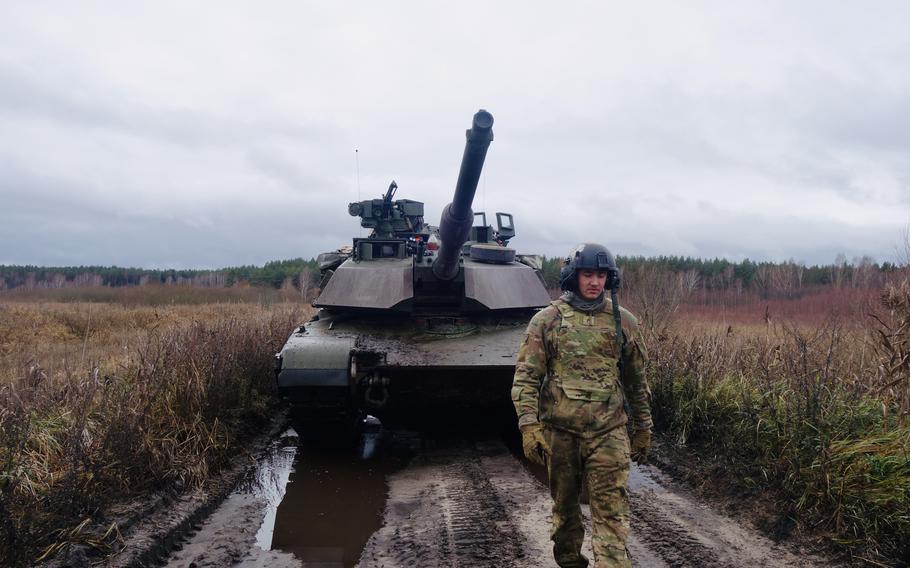
Staff Sgt. Jaden Brown, a tank commander with Alpha “Ares” Company, 3rd Battalion, 67th Armored Regiment. (Svetlana Shkolnikova/Stars and Stripes)
Russia has made no secret of its appetite for regaining former Soviet and imperial territory.
President Vladimir Putin last year likened himself to Peter the Great, praising the czar’s conquest of the Baltic coast in the 18th century as the “returning” and “strengthening” of land that was rightfully Russian. Mikhail Kasyanov, a former Russian prime minister under Putin, warned: “If Ukraine falls, the Baltic states will be next.”
Such rhetoric is empty talk for now, Pabriks said. But it is a clear indication of Russia’s desires and intentions.
“This is what they’re thinking, they’re not lying,” he said. “It’s just like Hitler wrote in ‘Mein Kampf’ what he will do, and everybody thought it was just a book. So when Russians are speaking, they will tell [their plan], and they can do it. We must not take this simply as a joke.”
In Pabradė, American soldiers tested Lithuania’s defenses against a major power, probing for weaknesses as Abrams tanks faced off against Lithuanian troops armed with anti-tank missiles in what one American tank commander described as a “giant laser tag game.”
“Bringing in all that heavy machinery against a much lighter force allows them to develop how they would act against a much better equipped, much larger force,” said Staff Sgt. Jaden Brown, a tank commander with Alpha “Ares” Company, 3rd Battalion, 67th Armored Regiment.
It is a learning opportunity for American service members as well. The thick woods that cover much of the Pabradė training area are a far cry from the desert landscape where the U.S. has fought recent wars in the Middle East.
In mid-November, the ground in Lithuania was soggy after weeks of rain, causing at least one tank to get stuck and several Bradley fighting vehicles to slide off dirt roads. Snow swirled as military personnel traded in SUVs for Joint Light Tactical Vehicles to navigate the grounds.
“It’s a very different environment for a lot of us and so we have to rely on our Lithuanian partners and be like, ‘Hey, how do we fight in this weather?’ ” said Capt. Joseph Camarata III, a battery commander for Charlie Battery, 1st Battalion, 9th Field Artillery Regiment. “We’re here not only to help the Lithuanians should a threat occur, but we’re here to learn from them as well, learn their culture, eat their cold beet soup that is the pinkest thing I’ve ever seen in my life and just see how they do things on this side of the world.”
The U.S. began sending long-term rotational forces of about 500 troops to Pabradė in 2019, and Lithuania, eager to turn the deployments into a permanent stay, inaugurated a new camp for American soldiers there two years later.
Today the base is teeming with construction, evidence of a $70 million investment by Lithuania to build barracks for several thousand soldiers, dining facilities and roads and to improve ranges for future combined fire exercises, said Lt. Col. David Griffith, commander of 3rd Battalion, 67th Armored Regiment.
“Probably once or twice a week, someone will reach out to me to be like, ‘Hey, any problems with the base right now? Any problems with training? Do you need anything?’ ” he said. “I haven’t experienced that before, where it seems like there’s such an effort here to make sure that we’re getting what we need.”
The Baltics sharply increased defense spending after Russia’s initial invasion of Ukraine in 2014 and are among the top contributing member states of NATO as a percentage of their economic output. Russia’s all-out war with its neighbor prompted Estonia, Latvia and Lithuania to pour even more money into their militaries, though their capabilities remain limited.
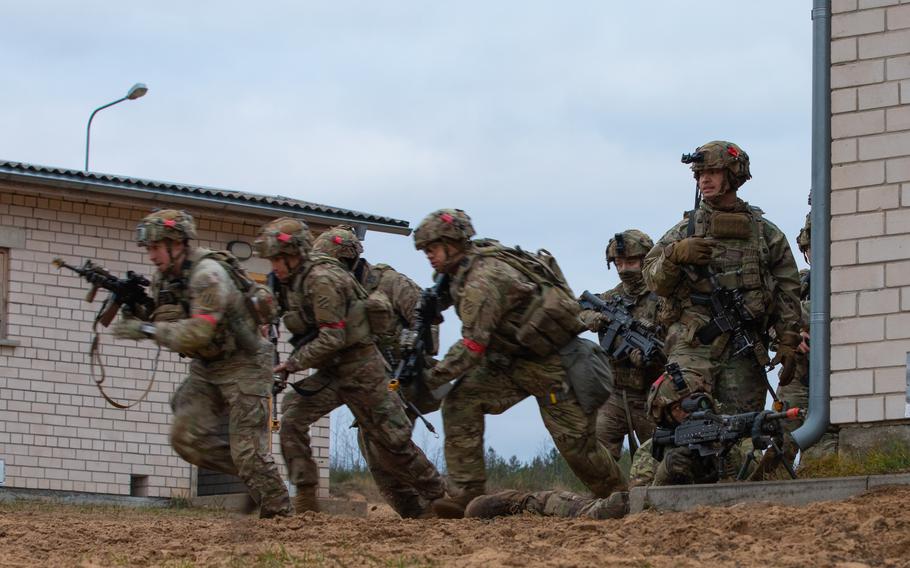
U.S. Army soldiers with Charlie Company, 3rd Battalion, 67th Armored Regiment, 2nd Armored Brigade Combat Team, 3rd Infantry Division, execute tactical movement on urbanized terrain during the Strong Griffin exercise at Pabrade Training Area, Lithuania, Nov. 17, 2023. (Cesar Salazar Jr./U.S. Army)
Latvia next year will mandate nine-month military service for 18- to 27-year-olds and is “making all possible efforts to develop our own military industry, logistic lines, just everything,” said Pabriks, the former defense minister. The country is also building the largest military training ground in the Baltics, hoping to provide a premier facility for foreign troops.
NATO has maintained multinational, battalion-sized battlegroups in the Baltics, led by Germany in Lithuania, Canada in Latvia and the United Kingdom in Estonia, since 2017 and reinforced them with additional personnel in response to the war in Ukraine.
But the Baltics want to see even more boots on the ground. They are asking for those forces to be beefed up by thousands in each state and are particularly interested in American troops and permanent U.S. or NATO bases, said Pabriks.
“Western military industries have been depleted for 30 years. There is not enough ammunition, there is not enough stocks, there is not enough U.S. presence in Europe,” he said. “European armies, most of the Western armies are quite weak actually.”
Only American forces are capable of commanding the sort of respect from Russia that makes the Kremlin think twice about an incursion, said Tomas Jermalavičius, research fellow for the Estonia-based International Centre for Defense and Security think tank.
“The biggest thing which impresses them most and which they fear most and which they sort of bang their chest and their posturing against the most is the Americans,” he said. “American firepower, American forces, American armor, American technology, American air power — this is what deters the most.”
The soldiers in Pabradė are keenly aware of the effect their presence, and their heavy military hardware, is having in the Baltic region.
“It assures our NATO partners and allies in theater,” said Griffith, the battalion commander. “Obviously us being here is a sign of commitment for U.S. forces.”
Hundreds of American service members are also in Latvia and Estonia, where the U.S. deployed HIMARS multiple-launch rocket systems and an infantry company late last year.
In Narva, a northeastern Estonian city that is separated from Russia by a river, Estonia is expanding surveillance along the border to keep better watch over its warring neighbor. There is no threat of an invasion, but the fear of war is never gone, said Eerik Purgel, who heads the border and migration control service in Narva.
“We have always known who Russia is and how Russia acts,” he said.
Russia’s all-out invasion of Ukraine did not come as a big surprise, Purgel said, and there is widespread belief in Estonia and the rest of the Baltics that their nations’ fate will ultimately hinge on its outcome.
“We are in a situation where it’s not our blood [being spilled] at the moment,” Purgel said. “But who knows what might happen next.”
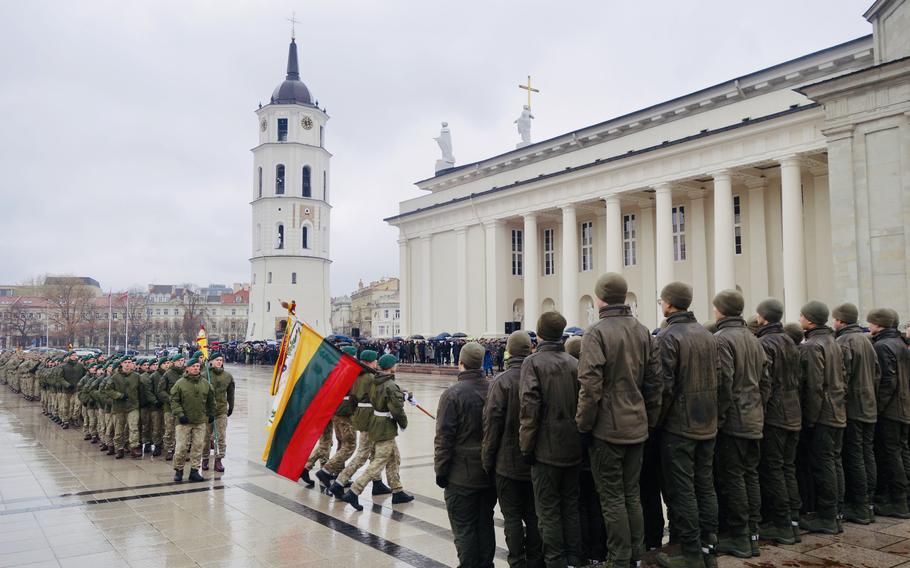
Lithuanian military cadets take the oath of service during a ceremony in Vilnius, Lithuania, on Nov. 15, 2023. (Svetlana Shkolnikova/Stars and Stripes)
Source: Stripes


